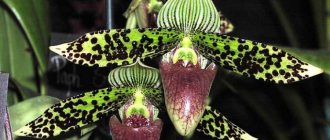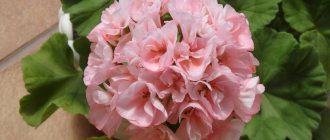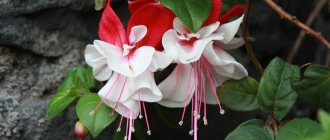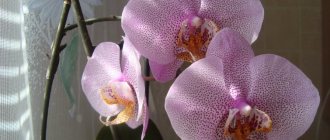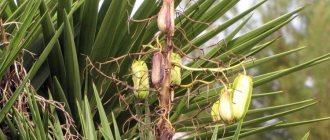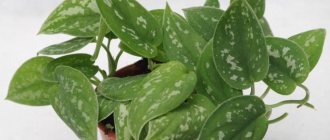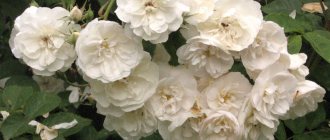Lantana is a relative of the well-known garden verbena and belongs to the same Verbenaceae family. The natural habitat of this shrub is the tropics; it is most widespread in the tropical regions of South America. Wild lantana can also be found in warm regions of Europe, where it came as a cultivated plant and acclimatized, turning into a weed. In Russia, lantana is grown as a houseplant and as a garden annual. It is valued primarily for its beautiful flowers, reminiscent of verbena flowers and capable of changing shade as they bloom.
Types of lantana
a hundred species in total, but the most cultivated plant is Lantana camara (1). This is an evergreen shrub with erect shoots up to 150 cm high (in indoor culture - 50 - 60 cm). The leaves are oval, green with a grayish tint, a sharp tip, a serrated edge and a specific odor. The flowers are small, tubular in shape, collected in a dense round inflorescence. As they bloom, their hue changes very noticeably, so lantana inflorescences can be two-colored, for example, yellow in the middle and red at the edges. Flowering is long, from early summer to mid-autumn. Some varieties are capable of setting seeds that look like dark berries. They are poisonous, so it is recommended to remove them.
There are hybrids and varieties of lantana vaulted on sale, but the range of them in stores is small. Mainly the following varieties are presented:
- Crocea – the flowers of this lantana variety are yellow at the beginning of bloom, gradually turning red;
- Mixta - flowers change shade from yellow to lilac;
- Nivea - the flowers are white, gradually acquiring a bluish tint, the inflorescences have an elegant “lace” appearance;
- Lyubava - buds and newly opened flowers are orange, turning red or pink when blooming; this variety of lantana flower is often offered in seed form.
Variety Crocea. Photo: pixabay.com
Mixta variety. Photo: pixabay.com
Variety Nivea. Photo: pixabay.com
Variety Lyubava. Photo: pixabay.com
There are other varieties of lantana, including those with monochromatic inflorescences, but it is difficult to find them on sale - for this you need to contact collectors.
Occasionally, in indoor culture you can find another type of lantana - Montevideo lantana (Lantana montevidensis) (2). It is more compact, has drooping shoots and pink-violet flowers that almost do not change shade.
Several spectacular varieties of the species
The classic colors of the species are limited to yellow, orange and red, but thanks to selection back in the 19th century, varietal forms with an atypical flowering palette were developed, for example, with a transition from white to yellow, purple or pink.
Variety "Lemon Glow"
- "Snow White" with creamy white blooms;
- variety "Lemon Glow" - white flowers changing color to yellow;
- "White Sun" white flowers with a yellow center;
- varieties with pink flowers, for example “Pink passion”
- varieties "Goldsonne" and "Sundancer" are decorated with completely yellow inflorescences;
- "New Red" in red and orange shades;
"New Red"
- 'Feston Rose' has deep pink blooms, while 'Brasier Rouge' has shades of pink and orange;
- Full orange flowers can be found in the Ortenburg Castle cultivar.
The most famous varieties of lantana with multi-colored flowers: “Tutti Frutti” (white-orange-pink), “Pink Passion” (cream-yellow-pink), “Confetti” (yellow-pink-red).
"Confetti"
It is worth paying attention to dwarf varietal forms, for example, “Cream Carpet”, which is only 30 cm high. The creeping variety “Sundancer” with yellow inflorescences looks good in hanging pots.
Caring for lantana at home
Caring for lantana is generally not difficult; the only difficulty in growing is maintaining the required temperature in winter, since the plant must be kept cool during the dormant period (3).
Priming
The soil for lantana requires light, air- and moisture-permeable soil, with moderate fertility, since in too nutritious substrates it actively forms green mass, but blooms worse. Indoor lantana can be planted in a ready-made soil mixture for flower crops, ficus or palm trees - the main thing is that it contains sand and raising agents (perlite or vermiculite).
To prepare your own soil mixture, you usually take leaf soil, humus and sand in equal parts.
Lighting
Like other beautiful flowering plants, lantana needs bright light. Direct sunlight usually does not harm it, with the exception of very young and newly transplanted plants; when grown in a south-facing window, they will require shading from the summer sun.
In winter, despite the dormant period, the plant should also be in a well-lit place.
Temperature
This is the only difficult moment in caring for a lantana flower. In the warm season, the optimal temperature for this plant is from 20 to 26 °C. In summer, it is very advisable to take it out into the fresh air - onto the veranda or balcony. The coolness of the night does not harm the plant unless the weather is extremely cold.
The wintering temperature of lantana is 10 - 16 °C or even slightly lower, and the plant should be in the light for at least 6 - 7 hours a day. Wintering in warmer conditions is acceptable, but has a bad effect on flowering, although lantana hybrids tolerate it better than species and varietal plants. During wintering, lantana may lose some leaves, but with the onset of spring its crown usually recovers.
When growing lantana in an apartment, you need to ensure that the plant is not in a draft, and that the leaves and pot do not come into contact with cold window glass or frame.
Watering
Watering lantana depends on the size of the plant and the phase of its life cycle: large-growing plants are watered more abundantly, and the watering regime differs in summer and autumn.
During the growing season, from spring to autumn, watering should be abundant and regular, 2 - 3 times a week, between waterings the top layer of soil should dry out. It is impossible to completely dry the substrate, as this leads to loss of foliage and buds.
In the cold season, when the plant is at rest, watering should be rare, once every 1.5 - 2 weeks, and moderate - so that the earthen ball becomes moist, but not wet. Overwatering is detrimental for this plant, as it leads to rotting of the roots.
Any water that gets into the tray must be drained immediately. Water for watering lantana should be soft, well-settled, and at room temperature. Periodic loosening of the soil after watering is very useful for lantana - this improves root aeration.
Humidity
The plant can easily tolerate low air humidity, but in such conditions it gets sick more often, grows slowly and blooms worse. It is advisable to spray lantana, especially in extreme heat and in the off-season, when the heating is still on. When spraying, water should not get on the flowers and buds, so it is best to place the blooming lantana in a tray with wet expanded clay, sphagnum or crushed stone.
Fertilizers
For feeding lantana, ready-made liquid mixtures intended for flowering indoor plants are suitable, in a concentration of 1/2 of that specified in the instructions.
Feeding
During the growing season, lantana is fed once every 2 weeks; during flowering and bud setting, the frequency of feeding can be increased to once a week. From mid-autumn until spring, when the plant is at rest, no fertilizing is applied.
Trimming
Pruning is very useful for lantana, as it stimulates tillering and the formation of young shoots on which flowers are formed. In early spring, before the growing season, the weak and oldest shoots of lantana are removed, and the remaining ones are shortened by about 1/3. Old shoots are considered to be those that have reached the age of 2 - 3 years. At the end of the season, you can shorten shoots that have grown too long. It is advisable to remove faded inflorescences before they form seeds.
Lantana flower: description and general information
Latin America is considered to be the birthplace of the plant. The culture belongs to the Verbenov family. The height of hybrid varieties is 1-2 m. When grown in pots, it grows about 50 cm.
Lantana boasts delicate flowers
- Stems are erect, highly branched.
- Leaves are emerald green. The length of the leaf plate is 5-10 cm.
- The inflorescences are umbellate or oval, collected from a large number of small flowers.
- Flower colors may vary.
After flowering, berries are formed, with seeds inside. When unripe, they are very poisonous. In the homeland of the plant, ripe berries are eaten.
Propagation of lantana at home
Lantana is not particularly durable: after 3 - 4 years the plant begins to age, produces fewer young shoots and, accordingly, blooms less often. There are 2 ways to propagate lantana.
By cuttings. A simple and convenient method, accessible even to an inexperienced gardener. To do this, cuttings up to 10 cm long with several pairs of leaves are cut from the tops of the shoots (you can use waste from spring pruning). It is best to root cuttings in the ground. Before this, the lower leaves are removed, the base of the cutting is dusted with Kornevin (4) and planted in a damp mixture of sand and peat. The container with cuttings is covered with transparent material and kept in a bright, moderately warm place (18 - 20 ° C). The substrate is periodically moistened with a spray bottle, the container is ventilated once a day.
After about 20 days, the cuttings take root, after which it is advisable to move them to a cooler place. When several leaves have formed on young plants, they can be planted in separate containers, pinching the tops to stimulate tillering.
Seeds. This method is more difficult. Seeds are sown in February (it can be earlier if it is possible to provide additional illumination with a phytolamp to the seedlings). The soil for sowing should be light and permeable - you can take a ready-made soil mixture for seedlings or for indoor plants and add vermiculite there. The seeds are lightly pressed into the moist soil, without sprinkling on top, the distance when sowing is 8 - 10 cm. The crops are covered with a transparent lid and kept in a bright place at a temperature of about 20 - 22 ° C. The substrate is periodically moistened, the container is ventilated daily.
After the seedlings emerge, the container with the seedlings is transferred to a cooler place, the lid is removed when two true leaves appear. When the young plants get stronger and reach a height of 10 - 12 cm, they can be planted in separate small containers. If lantana seedlings stretch out, this is a signal that the plants do not have enough light, so it is necessary to provide additional lighting or move the container to a brighter place.
general description
In nature, a lantana bush can reach 2 m. Indoor species are smaller - up to half a meter. The stem of the woody part is covered with thorns. The bush lends itself well to shaping. For example, in Thailand, lantana is shaped into a standard tree and several different varieties of flowers are grafted onto it.
The dark green leaves are similar in appearance to nettle leaves. Another nickname for the plant is “nettle.” Wrinkled leaf blades with jagged edges are attached to the stem on noticeable petioles. Among lantanas there are variegated species with variegated leaves that require more careful care at home.
Any description of a flower says that the main decoration of lantana is its bright inflorescences. The flowers of wild lantana species change color as they age, from bright yellow or pinkish to scarlet or peach. This is a kind of signal for pollinators.
New inflorescences open on lantana constantly, so one bush can delight with flowers of different colors, both completely red, for example, and completely yellow or multi-colored.
Botanists have also bred single-color varieties:
- White Dwarf - white inflorescences,
- Samantha - lemon yellow,
- Orange - orange.
A healthy indoor plant blooms in good light from April-May to October. Fruits usually do not appear in indoor conditions; there is not enough light and pollinators. Ripe fruits are black in color, with a bluish tinge. There are sterile varieties of the flower. They do not bear fruit, but form numerous inflorescences.
Lantana transplant at home
The best time to transplant lantana is the end of winter - the beginning of spring; you can do this simultaneously with spring pruning. The new pot should be only slightly larger than the previous one (2 - 3 cm), since in a container that is too spacious, lantana grows the root system to the detriment of the growth of the above-ground part and flowering.
The plant is removed from the pot along with the earthen lump; the roots are not cleaned, but only slightly shaken off from excess soil. When backfilling, carefully press down the soil without compacting it. When replanting lantana, make sure that the root collar is at the same level as in the previous pot.
After transplantation, the plant is watered and placed in a shaded place for several days. There is no point in replanting lantana that is more than 3-4 years old - it is easier to cut it out.
Propagation by cuttings
For cuttings, take the upper green part of the shoot, flexible and not woody. The collection of cuttings is combined with formative pruning of bushes. The cuttings take root quite successfully. It is important here to provide them with humidity, using any homemade “greenhouse”, a plastic bottle, for example. Take care of temperatures above 20 ° C and bright lighting.
The cut cutting takes root:
- in peat tablets,
- in mixtures of peat, perlite and vermiculite,
- in water.
Substances to improve root formation will also be beneficial. Transplant the cutting into a flowerpot when its first pot is filled with roots.
Lantana diseases
Root rot. A dangerous lantana disease that can very quickly destroy the plant. Appears due to improper watering or too dense a substrate - all this leads to stagnation of moisture in the soil. Signs of root disease are stunted growth, falling leaves, buds and flowers.
The diseased plant must be removed from the pot and the roots examined. If the root system is severely affected, it will no longer be possible to save the plant. In case of minor damage, the rotted roots are removed, the root system is cleared of soil and soaked for some time in a pink solution of potassium permanganate or a fungicidal preparation (Ordan, Alirin-B, Vitaros (4)). The plant is transplanted into fresh soil, which can be treated with a liquid fungicide according to the instructions for prevention.
Gray rot. It affects the above-ground part of the plant and appears mainly on weakened plants that are kept in unsuitable conditions (strong shading, insufficient or excessive fertilizing, drafts, improper watering). Signs of this disease are watery spots on the leaves and shoots, which increase in size over time and become covered with a characteristic grayish coating. The affected parts of the plant soften and die.
To combat gray rot, remove all affected parts of the plant and treat it with a fungicide (Hom, Bordeaux mixture 1%, Topaz, Skor (4)). It is also advisable to treat the surface of the soil in the pot. In case of severe damage, several treatments may be required at a certain time interval.
Propagation by seeds
Even ideal care in indoor conditions rarely leads to the appearance of fruits. Seeds are either purchased ready-made or obtained from mature fruits of plants living outdoors.
In order to obtain a sprout, a finished seed
- soak for a day in a growth stimulator,
- germinated in damp cotton cloth,
- the hatched seeds are sown in the ground,
- create a “greenhouse”, covering it with glass or film
Bottom heating is required, temperature 22-25 °C. The plant germinates slowly; it will take more than 10-15 days for a sprout to emerge. When a pair of true leaves is formed, they begin to harden the sprout, opening the “greenhouse” slightly, and the temperature is reduced to 14-16 °C.
To grow at home, dried ripe lantana berries are first kept in a thermos for 2 hours at 50 °C, then the shell is removed. Then they are treated as with ready-made seeds.
Lantana pests
Lantana can suffer from typical houseplant pests - aphids, spider mites, mealybugs, scale insects and whiteflies.
Aphid. A small insect without wings, most often greenish, which can be seen with the naked eye or with a magnifying glass with a slight magnification. Aphids usually cluster on the undersides of leaves.
Whitefly. A winged insect that can be seen not only on the plant itself: frightened whiteflies easily rise into the air and fly around. Some gardeners notice that the whitefly is the most common pest of lantana flowers.
Spider mites and mealybugs. They manifest themselves primarily as traces of vital activity: this is a cobweb coating on leaves and shoots or characteristic “cotton lumps” and sticky secretions on the leaves. If you carefully examine the plant, you can see small crawling pests on the back of the leaves and in the axils.
Scale insect (or false scale insect). This lantana flower pest is easily identified by specific oval brownish “growths” on parts of the plant. With severe damage, they can merge into a continuous crust.
To control pests in the initial stages, you can use green soap - the plant is washed with it several times at intervals of a week and a half. The scale insects are removed mechanically, carefully scraping off the stems and leaves.
If there are a lot of pests and they have thoroughly colonized the plant, you will have to resort to agrochemicals. For aphids, whiteflies, and mealybugs, you can use Fitoverm or Actellik; for spider mites and scale insects, it is better to use Aktara (4).
Distribution
Antillean crested hummingbird feeding on L. camara
Native range Lantana camara
Central and South America; however, it has become naturalized in approximately 60 tropical and subtropical countries worldwide.[19][20] It is common in eastern and southern Africa, where it occurs at altitudes below 2000 m, and often invades previously disturbed areas such as registered forests and areas cleared for agriculture.[21]
L. camara
also colonized areas of Africa, Southern Europe such as Spain and Portugal, as well as the Middle East, India, tropical Asia, Australia, New Zealand and the United States, as well as many islands of the Atlantic, Pacific and Indian Oceans.[22][23] It became a significant weed in Sri Lanka after escaping from the Royal Botanic Gardens in 1926.[24][25]
It was brought to the Philippines from Hawaii as part of the US-Philippines exchange program; however, he managed to escape and became naturalized in the islands.[26]
Range of L. camara
continues to grow, as evidenced by the fact that it has invaded many islands where it was not present in 1974, including the Galapagos Islands, Saipan and the Solomon Islands.[23]
There is also evidence that L. camara
is still expanding its range in regions where it was established for many years, such as East Africa, Australia and New Zealand.[9]
L. camara's
ability to rapidly colonize disturbed areas of land has allowed it to spread to countries where activities such as deforestation, land clearing for agriculture and forest fires are common.
In contrast, in countries with large areas of intact primary forest, the distribution of L. camara
has been limited.[9][27]
Popular questions and answers
Agronomist-breeder Svetlana Mikhailova answered typical questions from amateur flower growers
How to choose lantana?
Lantanas are very rarely sold in retail stores, so you will have to look for the plant in online stores or from collectors. This is the case when the plant cannot be inspected before purchasing, so look online for reviews about the store or private seller from whom you intend to buy the plant and the quality of its product.
What kind of pot do you need for lantana?
The pot for lantana should be about 3 cm wider than the root system. The depth of the pot must be chosen so that a layer of drainage 3-4 cm thick fits on the bottom. A clay pot is preferable: firstly, it heats up and cools more evenly, and, secondly, it is weighty and will become an additional “counterweight” for stability plants, because the crown of lantana is quite large and heavy.
Is it possible to root lantana cuttings brought from the south?
Of course, you can take a risk, although long transportation of the cutting reduces its chances of rooting. The cuttings may take root, but the likelihood of good growth and flowering of such lantana is not very high. Varieties and hybrids that are grown indoors are adapted to conditions that are very different from natural ones. An “outdoor” plant is unlikely to feel good in them.
Is it possible to grow lantana in open ground?
It is possible, in the Moscow region it is sometimes planted in flower beds as an annual, and in the southern regions - as a perennial. Sometimes lantana is used as a garden container crop: this is convenient, since the pots can be brought to a cool terrace for the winter, where the plant can safely overwinter.
Management and control
Butterfly feeding on L. camara
Effective treatment of invasive L. camara
in the long term, reductions in activities that create degraded habitats will be required. Maintaining functioning (healthy) ecosystems is key to preventing invasive species from establishing themselves and crowding out native ones. fauna and flora.
Biological
Insects and other biocontrol agents have been implemented with varying degrees of success in attempts to control L. camara
. It was the first weed to undergo biological control; however, none of the programs were successful despite using 36 control agents in 33 regions.[40]
The lack of success with biological control in this case is most likely due to the multiple hybrid forms of L. camara
, as well as its large genetic diversity, which makes it difficult for control agents to effectively kill all plants. A recent study conducted in India showed some results regarding the biological control of this plant by tingid bugs.[41]
Mechanical
Mechanical control of L. camara
involves the physical removal of plants. Physical removal can be effective, but is time-consuming and expensive.[6] therefore removal is usually only practical in small areas or in the early stages of infestation. Another method of mechanical control is fire treatment followed by revegetation with native species.
Chemical
Use of herbicides to control L. camara
very effective but also expensive, which prohibits its use in many poorer countries where
L. camara
is well established. The most effective way to chemically treat plant species is to first mow the area and then spray it with herbicides, although this can have serious environmental consequences.
Sources
- A working list of all plant species. Lantana camara // The Plant List https://www.theplantlist.org/tpl1.1/record/kew-107934
- A working list of all plant species. Lantana montevidensis // The Plant List https://theplantlist.org/tpl1.1/record/kew-1081813
- Hessayon D.G. All about indoor plants // M.: Kladez-Buks, 20054
- State catalog of pesticides and agrochemicals approved for use on the territory of the Russian Federation as of July 6, 2022 // Ministry of Agriculture of the Russian Federation https://mcx.gov.ru/ministry/departments/departament-rastenievodstva-mekhanizatsii-khimizatsii- i-zashchity-rasteniy/industry-information/info-gosudarstvennaya-usluga-po-gosudarstvennoy-registratsii-pestitsidov-i-agrokhimikatov/Cover photo: pixabay.com



